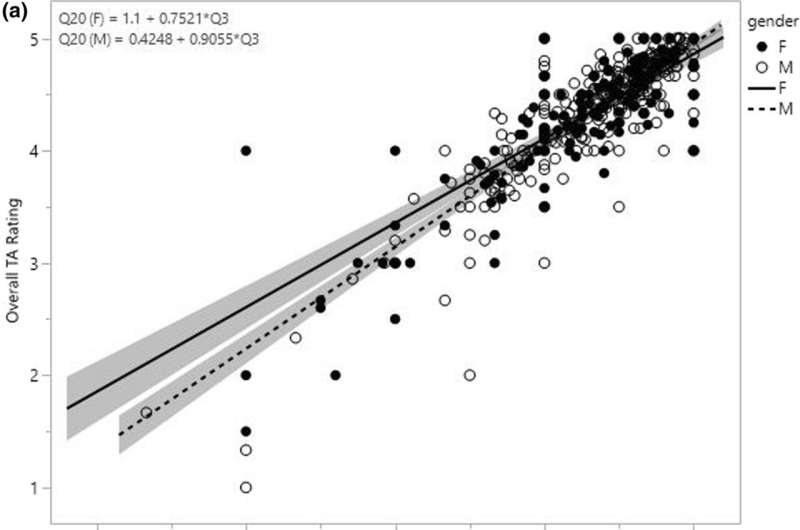Gender can shape how teaching assistants are evaluated, study finds

Male teaching assistants are more likely to receive higher ratings than their female counterparts, and both genders are perceived as more valuable when exhibiting traits historically associated with their respective roles in society, a Cornell study finds.
The study of doctoral engineering TA evaluations was published in the International Journal of STEM Education and shows how the well-studied biases in assessments of faculty can occur in other parts of academia.
“Growing up as a girl in this culture, you get a lot of messages about where you do and don’t belong,” said Lisa Schneider-Bentley, director of Engineering Learning Initiatives at Cornell Engineering and co-author of the study.
“We want to build awareness around the potential for bias in one of the key places where a young woman progressing toward an advanced degree in engineering is getting feedback, which may have a strong encouraging or discouraging impact on her persistence on that pathway.”
The study examined five semesters’ worth of TA evaluations and used statistical models to compare survey questions about specific skills with overall quality ratings for male- and female-identifying TAs.
Undergraduates evaluating their TAs were asked to provide numerical ratings for specific questions about TA performance associated with traits such as knowledge, teaching strategies, preparedness, and fairness. In addition, narrative prompts included “Comment on the TA’s teaching strengths as well as areas in which improvement is needed” and “Comment on the TA’s communication strategies.”
The analysis found that across all performance-based survey questions, male TAs had a higher likelihood of receiving a better rating than their female counterparts, and both genders were valued more for behaviors congruent with roles historically ascribed to them. For instance, female TAs tended to receive lower overall quality ratings if they were assessed as poor communicators or unsupportive, while males scored lower if they were seen as having low levels of knowledge or expertise.
“We saw that females were more likely to have reduced ratings in general, and their overall TA ratings were further reduced if they weren’t doing things like actively checking in on students or providing periodic summaries and visual aids,” said Celia Evans, associate director of Engineering Learning Initiatives and lead author of the study. “But we also saw that if males weren’t enacting an “I’m in charge’ sort of behavior, their overall TA quality ratings were likely to be lower relative to males who were.”
Engineering Learning Initiatives promotes evidence-based teaching and learning within Cornell Engineering, and its programs include new practices based on the study’s results. Mid-semester evaluations now place rating-scale questions last on the survey and invite students to reflect more deeply about specific interactions with TAs before giving them an overall rating.
“We want students to give feedback about the teaching, not about the person, and to be specific about what the TAs did and didn’t do well in the classroom,” Evans said. “That’s the most valuable part of the evaluation, and we hope having that first can reduce the bias we see in the numerical ratings.”
Another evidence-supported change is an update to evaluation instructions, which now include a reminder for students to consider how their answers could be influenced by implicit biases and expectations associated with culture, race, ethnicity, and gender.
“Most biases are unconscious, a result of the sum total of our lived experience,” Evans said, “as long as there are perceived notions that people should and shouldn’t be in certain roles, there’s a high probability that biases will persist. Regardless of intent, the biases uncovered in this study represent barriers to the advancement of, primarily, young women engineers.”
Schneider-Bentley said the study was an opportunity to better unto understand betterderstand bias-related patterns in student evaluations of graduate TAs’ teaching effectiveness.
“It was important to publish the study so that others could be encouraged to also employ evidence-supported practices to reduce bias, especially in STEM disciplines where women and other populations are underrepresented,” Schneider-Bentley said. “Teaching evaluations can influence the decisions that women in engineering make, or that others make, about their futures. At Cornell Engineering, we want to make a positive difference.”
More information:
C. A. Evans et al, Gender patterns in engineering PhD teaching assistant evaluations corroborate role congruity theory, International Journal of STEM Education (2024). DOI: 10.1186/s40594-023-00460-5
Citation:
Gender can shape how teaching assistants are evaluated, study finds (2024, February 28)
retrieved 28 February 2024
from
This document is subject to copyright. Apart from any fair dealing for the purpose of private study or research, no
part may be reproduced without the written permission. The content is provided for information purposes only.
Science, Physics News, Science news, Technology News, Physics, Materials, Nanotech, Technology, Science
#Gender #shape #teaching #assistants #evaluated #study #finds
